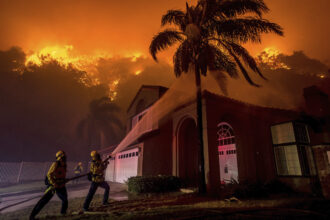Increasingly bold climate protests are triggering a wave of harsh new laws in Western nations that aim to prevent the type of disruptive demonstrations experts say have long played an important role in healthy democracies.
From Mahatma Gandhi’s non-violent resistance to British rule in India to Martin Luther King Jr.’s famous civil rights marches in Jim Crow America, many of the freedoms people enjoy around the world today are owed in large part to social protest movements and civil disobedience. In recent demonstrations that have caught international attention—including climate activists splattering food onto the glass covers of famous artwork, letting the air out of SUV tires en masse and even shutting down airports in several different countries on the same day—protesters have pointed to those historical moments as both their motivation and justification for their actions.
Last week, climate activists dumped baking flour on a sports car painted by the famous U.S. pop artist Andy Warhol that is on display in Italy’s financial capital.
But as climate protesters adopt more radical tactics to highlight what they say is a world moving far too slowly to prevent catastrophic global warming in the coming decades, they’re being met with a slew of new anti-protest laws from policymakers who say the demonstrations are going too far.
In Britain, climate protests that have jammed highways and disrupted places of commerce have emboldened lawmakers to pass new legislation that gives police broad new powers to regulate demonstrations. That includes being able to dictate when a protest can take place and how loud it gets. The new law also threatens protesters who block highways with harsh new penalties, including up to six months in prison and unlimited fines. And lawmakers are also considering new legislation, known as The Public Order bill, which could extend those penalties to protesters who lock themselves onto construction sites or other places of business, as well as give police new powers to stop and search someone for a “protest-related” offense.
In Australia, lawmakers passed a new law in April that similarly increased penalties on protesters who disrupt economic activities, turning what was once a $400 maximum fine into a $15,000 one, with the possibility of serving up to two years in jail.
In the United States, too, protests that have been broadly tied to environmental, social and climate justice issues, such as demonstrations attempting to halt construction of major international oil and gas pipelines, have triggered new laws in more than a dozen states. In some of those cases, trespassing and “impeding” the operation of pipelines, power plants and other “critical infrastructure” can now lead to a felony conviction.
“Protest is a fundamental right, not a gift from the state,” Martha Spurrier, director of U.K.-based civil rights organization Liberty, said at a recent press event in reaction to the new anti-protest laws in Britain. “Our right to protest continues to be attacked by a government intent on making it harder for people to stand up for the causes they believe in.”
Proponents of the new laws say they’re necessary to prevent a “small minority of protesters” from causing significant disruptions to daily life, which they say can inflict serious economic losses on businesses and taxpayers and even put lives at risk. Last month, for example, German officials blamed at least one death in Berlin on activists after a climate protest delayed emergency responders trying to reach a traffic accident. Developers for Britain’s HS2 high-speed railway line have also claimed that protests against the project have increased its costs by about $145 million.
But human and civil rights groups say the laws pose a serious threat to free speech, which they call “an integral part of democracy.” And many of those laws now face legal challenges, including at least one lawsuit over Australia’s new anti-protest law that will be heard in front of the nation’s supreme court.
Many activists have also argued that they’ve had no choice but to adopt bolder tactics after their governments have failed for decades to adequately respond to the climate crisis, which scientists say is exacerbating natural disasters and food insecurity in many parts of the world and driving the extinction of plants and animals to levels not seen in the last 10 million years. Meanwhile, the world’s governments and financial institutions continue to fund new fossil fuel development at record levels.
In fact, as the pivotal COP27 global climate talks came to a close last week, some delegates expressed immense frustration that more wasn’t being done to reduce the world’s dependence on fossil fuels. Without further intervention, climate experts say, the world will quickly overshoot the Paris Agreement target of limiting average global warming to 1.5 degrees Celsius by the end of the century. Instead, they say, the planet remains on track to warm between 2 and 3 degrees Celsius by that time—a scenario that would bring about devastating ecological consequences in the coming decades, including far more deadly natural disasters and an accelerating mass extinction crisis.
Yet the most recent climate protests, especially ones including famous artwork, have sparked heated debate within the climate movement over what’s the “right” and “wrong” way to protest. While there’s plenty of research that suggests civil disobedience and confrontational protests are quite effective at spreading awareness of social movement causes, blocking specific projects and even normalizing social movements in the eyes of the public—a phenomenon sociologists call the “radical flank effect”—more recent research also suggests that disruptive protesting can be counterproductive.
A 2020 study found extreme protest actions can reduce the overall popularity of a social movement. A study released earlier this month that surveyed more than 1,300 people in Germany, where several of the climate protests targeting artwork have taken place, found that 83 percent of the respondents thought the demonstrations had gone too far. And another study published this month, conducted by renowned climatologist Michael Mann and University of Pennsylvania political scientist Shawn Patterson Jr., found that 46 percent of the public said they became less sympathetic to the aims of climate protesters after witnessing demonstrations involving famous artwork.
“I have devoted much of my time and effort over the past several decades to the cause of meaningful climate action” and “worried that events like this could harm the cause to which I (and so many) have devoted my life,” Mann wrote in a recent opinion essay for TIME Magazine, referencing the protest where two activists threw tomato soup on a Vincent van Gogh painting. “From a communications standpoint, the protest seemed like an even bigger mess than the soup-splattered painting.”
On Tuesday, two climate activists who had glued their hands to an 18th century frame containing a separate van Gogh painting, were also found guilty of causing criminal damage to it. The painting itself was unharmed.
Still, many climate activists have said they’ll continue participating in confrontational and disruptive protests until their governments do more to address the climate crisis, and urge their leaders to ban new development of fossil fuels. More than 2,000 activists have been arrested in the U.K. due to disruptive climate demonstrations, activists said, and as the COP27 climate talks wrapped up over the weekend, more than 30 protesters remained in jail for demonstrations that took place during the summit.
“Until they put the death sentence as the repercussions for what we’re doing, it won’t deter us,” Cameron Ford, a spokesperson for Just Stop Oil, one of the core groups coordinating the recent protests, told the Guardian last month. “Because the alternative to us not getting the change that we’re demanding is death.”
That’s it this week for Today’s Climate, thanks for reading. I’ll take a break from the newsletter this Friday to observe Thanksgiving and continue my ongoing search for the perfect pie. Look for me in your inbox next week—but before you go:
Hot Gossip
Record snowfall in upstate New York led to a surge of climate disinformation online, recirculating a long-debunked myth that global warming can’t be real if we’re getting more snow. This BBC journalist took the time to debunk the myth again.
And Republicans are expected to eliminate the House’s Select Committee on the Climate Crisis when they retake power in the lower chamber next year. So what are they hoping to concentrate on instead? You may have guessed it: more oil and gas.
Today’s Indicator
15.1 billion
That’s how many metric tons of carbon dioxide emissions are expected to be released from coal-fired power plants worldwide this year, u003ca href=u0022https://www.eenews.net/articles/coal-emissions-on-pace-for-record-setting-2022/u0022u003eaccording to a new report from the International Energy Agencyu003c/au003e, putting 2022 on track to break the previous all-time record for coal emissions.
Top News from Our Warming World
COP27 Did Little to Advance the Nature Loss Agenda for Next Month’s UN Conference – Reuters
Junk Carbon Offsets Are What Make These Big Companies ‘Carbon Neutral’ – Bloomberg
To Meet Climate Mandate, New York Needs to Learn How to Build Clean Energy Again – New York Focus



















